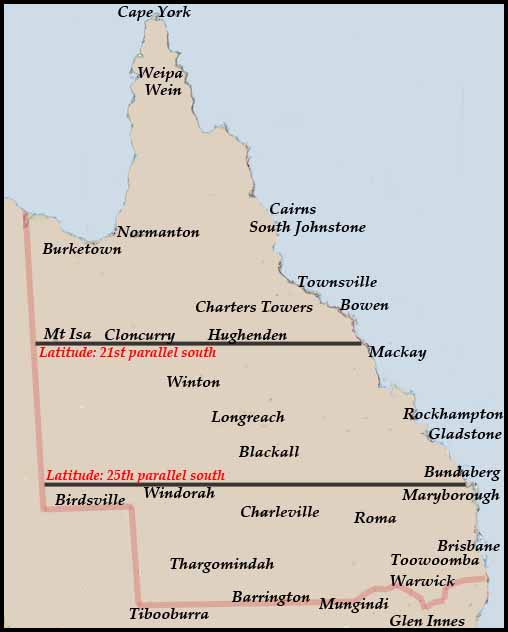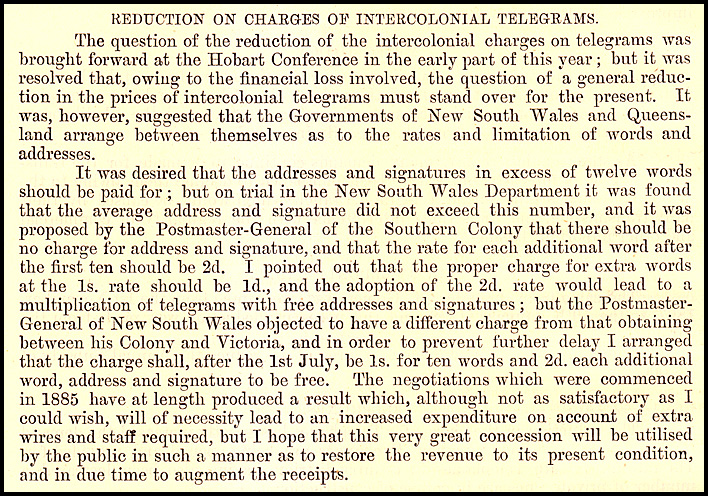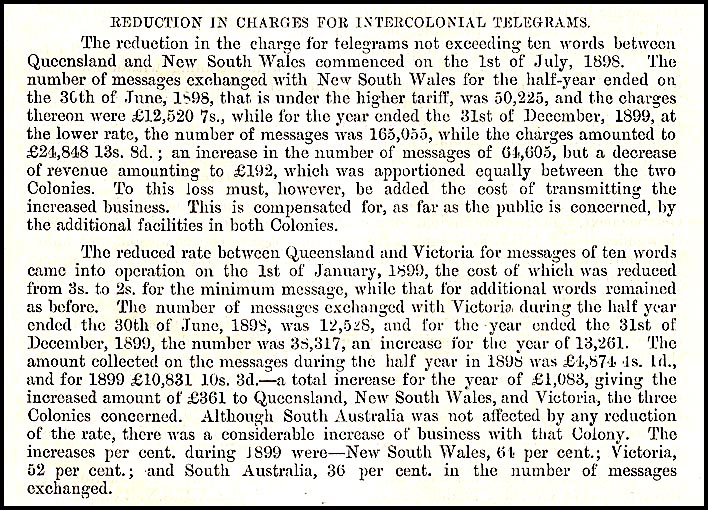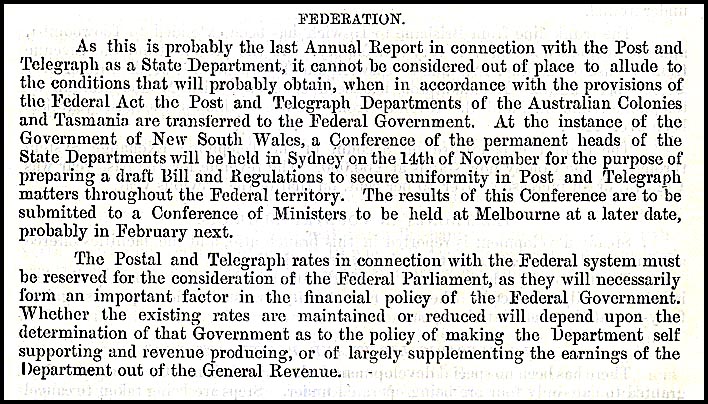Telegram rates.
- Australia 1901-1988
- New South Wales
- Queensland
- South Australia
- Tasmania
- Victoria
- Western Australia
- International
- Special aspects
Telegraph rates in Queensland to 1901 were, for some time, based upon a complex arrangement of nominated telegraph stations. As more lines were constructed, the regulations became much simpler and easier to apply to particular telegrams.
Complicating the calculations was the special and additional rates applied for telegrams sent to another Colony. Hence in the following discussion, within-Queensland rates are presented before the inter-colonial rates in each period.
The main rate periods were:
- 1861 to 1870;
- July 1870 to August 1870;
- August 1870 to 1872
- 1872 - 1876;
- 1876 - 1892;
- 1892 - 1897;
- 1897 - 1899.
1861-1870 rates:
(a) within Queensland.
| Telegram from | to Station at | First 10 words | Each additional word |
| Brisbane | Lyton or Ipswich. | 2/- | 2d. |
| Gatton. | 2/6 | 2d. | |
| Toowoomba, Drayton or Warwick. | 3/- | 3d. | |
| Toowoomba, Drayton or Warwick. | Tenterfield or Glen Innes. | 4/- | 3d. |
(b) Inter-Colonial.
| Telegram from | to Station at | First 10 words | Each additional word |
| Brisbane | NSW - 13 offices on NSW-Qld line (Tenterfield, Glen Innes, Armidale, Tamworth, Murrurundi, Muswellbrook, Singleton, West Maitland, Morpeth, Newcastle, Wollombi, Windsor, Sydney). | 6/- | 4d. |
| NSW - 13 offices west of Sydney. | 7/- | 4d. | |
| NSW - 10 offices south of Sydney plus Echuca (Vic). | 8/- | 4d. | |
| Victoria - 43 offices. | 9/- | 6d. | |
| South Australia - 21 offices. | 12/- | 8d. |
When the Telegraph Office opened at Gunnedah on 7 June 1869, the Brisbane Courier noted that telegraph rates would be the same as to Tamworth - namely 6/- for 10 words and 4d for each additional word.
The earliest recorded inter-colonial telegram sent between Brisbane and Sydney (NC-DO-1) was sent on 11 August 1863 and bore the instructuonal marking 6/- Collect.
From 1 October 1861, "telegraphic messages on her Majesty's Service will be transmitted without prepayment. Such telegrams are in every case to be marked "On Her Majesty's Service" and must not contain any words relating to matters of a private nature".
(a) within Queensland.
A new approach was introduced based on how far the message was to be sent within Queensland.
| Distance message sent | First 10 words | Each additional word |
| Under 50 miles | 1/- | 1d. |
| 50 - 99 miles. | 1/6 | 1d. |
| 100 - 149 miles. | 2/- | 2d. |
| 150 - 199 miles. | 2/6 | 2d. |
| 200 - 299 miles. | 3/- | 3d. |
| 300 - 399 miles. | 4/- | 3d. |
| 400 - 499 miles. | 5/- | 4d. |
| 500 miles and over. | 6/- | 4d. |
These charges were exclusive of address and signature - for which 10 words were allowed.
(b) Inter-Colonial.
| Telegram from | to Station in | First 10 words | Each additional word |
| 15 southern stations in Qld. | NSW | 4/- | 3d. |
| 18 central stations in Qld. | NSW | 6/- | 4d. |
| 8 northern stations in Qld. | NSW | 8/- | 4d. |
| All Queensland stations. | Victoria | 9/- | 6d |
| South Australia | 12/- | 8d. | |
| Tasmania (land line only) |
10/- | 7d. |
As from January 1879, the charge for messages sent by the Tasmanian cable were reduced from 5s to 4s for 10 words.
For every additional five words or part thereof, the charges were reduced from 2s 6d to 2s.
Thus the cost of a message of 10 words from Brisbane to Tasmania, inclusive of land charges - which amount to 10s - will be 14s.
Address and signature was limited to 10 words.
The previous classification of the Colony into eight distances was quickly revised as it worked against telegrams being sent within larger sections of the Colony. Hence one month later, the distances were rearranged into three ranges and three defined sections:
 |
The defined sections are as shown in the map:
Hence from Townsville to Mackay cost 3/6 for 10 words but from Townsville to Maryborough cost 4/6. |
All Colonies passed a Telegraph Messages Act about 1872. It was aimed at establishing the legal identity of a telegram, its existence and its connection between the sender and the recipient.
The Queensland Act of 1872 also included a revision of the inter-colonial telegraph rates:
| Telegram from | to Station in | First 10 words | Each additional word |
| Southern Queensland | NSW | 4/- | 3d. |
| Central Queensland | NSW | 6/- | 4d. |
| Northern Queensland | NSW | 8/- | 4d. |
| All Queensland stations | Victoria | 6/- | 4d. |
| South Australia | 12/- | 8d. | |
| Tasmania (land charges) |
7/- | 6d. | |
| Tasmania (cable charges) |
4/- | 2/- for every extra 5 words or portion thereof. |
In February 1873, an announcement in newspapers was made to the effect that "The Queensland telegraphic rates have been lowered to the same as in New South Wales". The new rate was 2/6 for 20 words for ordinary rate telegrams sent anywhere in Queensland.
The Postal Conference, lately sitting in Sydney resolved, subject to the approval of the several Governments, that after the 1st of November 1873, intercolonial messages of ten words may be sent at the rate, exclusive of address and signature, of 1s. to each colony and 1d. for each additional word.
Messages not exceeding 10 words, exclusive of names and addresses, will be forwarded from any station in the colony to any other station within the same limits, at a uniform rate of 1s. each.
This arrangement does not however apply to any of the stations west of Cardwell, on the line between Cardwell and Norman Mouth.
- messages as above will be despatched between Cardwell or any station south of it and any station in New South Wales, at a fixed rate of 2s. each; or
- to or from any station in Victoria, or such portion of South Australia as lies south of Port Augusta, at 3s. each;
- the rate for a similar message, from any part of Queensland south of Cardwell to Tasmania, will be 4s. including both land charges and cable rates.
These charges may be expected to almost revolutionize the use of our various telegraph lines and cause them to be employed as a medium of intercourse to an extent of which we have at present little conception. The initiation is delayed until November in order to give time to erect additional wires to carry the increase in business which may be anticipated.
The Telegraph Message Amendment Act of 1876 established a uniform rate for telegrams sent within Queensland. It incorporated the recommendation accepted at the Intercolonial Conference held at Sydney in January/February 1873 for "each of the Australasian colonies (charge) one shilling for 10 words (exclusive of address and signature) and one penny for each additional word" ...(not including cable related charges). These charges were published in the Queensland papers in late December 1876.
The Act also established a single rate for sending a telegram from a station anywhere in Queensland to each Colony - these rates based on a word count which excluded address and signature.
| Telegram from | to Station in | First 10 words | Each additional word |
| Any station in Queensland | Any station in Queensland | 1/- | 1d. |
| NSW | 2/- | 2d. | |
| Victoria | 3/- | 3d. | |
| South Australia | 4/- | 3d. | |
| Any Overland Telegraph station | 13/- | 1/- | |
| Tasmania (only 10 words allowed free for address and signature) | 8/- | 9d. |
Press Telegrams sent within Queensland or to any of the other Colonies were charged at half the ordinary rates even if lodged after normal working hours.
Telegrams to New Zealand (with address and signature included in the word count) cost 10/6 for 10 words and 1/- for each additional word.
Press messages for publication were half the ordinary rate up to 1883. In January 1884, the inter-colonial press rate between Queensland and New South Wales was reduced to 3/- per 100 words. It was also resolved to reduce the Queensland Colonial press rate to 1/- per 50 words or part thereof as soon as arrangements could be made - especially making the necessary lines available. There is a good report of the situation in the Capricorns of 25 September 1885 in which it is pointed out that a press message of 100 words sent from Rockhampton to Sydney costs 3/- while the same message sent to Brisbane costs 4/3.
The 1888 report states:'The (Cape York) line was opened with a cable rate of 2 shillings added to the ordinary rate, but on the 6th April the charges were accumulated to those between any other Queensland stations and the other colonies; thus, South Australia could send a ten word message to Thursday Island for 3 shillings; with 3 pence for each extra word, while Queensland is charged 9 shillings and 9 pence for each extra word if sending a telegram to Port Darwin".
An example of paying the 2 shilling inter-colonial rate to NSW in 1891 is shown elsewhere.
27 May 1892 to 27 October 1897.
An Executive Council decision in 1892 established the following new rates - address and signature still not charged. This exclusion is interesting because the Postal and Telegraph Conference, held from 24 February to 3 March 1890, accepted the decision to adopt "the almost universal practice of counting names and addresses and including them in the charge ... but the acceptance and registration of code addresses should be strictly prohibited except for international cablegrams".
| Telegram from | to a Station in | First 10 words | Each additional word |
| Brisbane G.P.O. | a radius of 8 miles from the G.P.O. | 6d. | 1d. |
| Any other station in Queensland. | Queensland beyond the 8 mile radius |
1/- | 1d. |
| Any Queensland station. | NSW Border stations (see below) |
1/- | 1d. |
| Queensland. | NSW | 1/- | 2d. |
| Victoria | 3/- | 3d | |
| South Australia | 3/- | 3d | |
| Overland Telegraph stations (variable) |
5/- to 9/- | 5d. to 9d. | |
| Tasmania | 4/- | 4d. | |
| Western Australia | 4/- | 4d. | |
| Western Australia (via Roebuck) | 12/- | 1/1 |
The Queensland Border towns were listed as Goondiwindi, Texas, Wallangarra and North Killarney.
The NSW Border Stations were: Angledool, Barrigun, Goodooga, Hungerford, Mungindi, Murwillimbah, Tumblegum, Tweed Heads and Yetman.
Press telegrams now had a very detailed list of charges:
- within Queensland, the charges were 1/- for 24 words (including address and signature) plus 1d for each 4 extra words of part thereof;
- to each of the other Colonies and including New Zealand based on a minimum charge of 10 words;
- to New Caledonia at 4d per word.
These Press rates were adjusted slightly on 8 September 1897 with a reduction from 50% extra on Press cable rates for Sunday transmission reduced to the ordinary rate.
Sunday telegrams, both inland and inter-colonial:
(a) "Urgent" and ordinary messages one hundred (100) percent more than the usual daily rate;
(b) {ress messages, fifty (50) percent more that the usual daily rate;
No telegrams will be transmitted after 10:00 pm on Sundays.
27 October 1897 - 30 June 1899.
Within Queensland rates.s
The main change was the introduction of an URGENT rate for telegrams (see Urgent rates and QI-DU-1). It was set at double the ordinary rate.
As from August 1897, "to greatly convenience the suburban public in the matter of telegraph messages, it is intended to establish a sixpenny rate, to apply within a radius of six miles of the suburban Post Offices, the fee covering all messages of ten words or under, one penny per word being charged for each additional word". This change took effect on 29 October.
Inter-Colonial rates.
There were many discussions amongst the Postmaster-Generals of Queensland, New South Wales and Victoria concerning a reduction in the Inter-Colonial rates. Although the Queensland Government had long been an advocate for reductions, the difficulty of having different bases for charges from NSW was the problem. In one form or another, the discussions had dragged on since 1891. Some of the issues are described elsewhere.
Finally changes were made to the inter-colonial rates as follows:
- on 1 July 1898 to NSW: 1/- for 10 words and 2d for each additional word with signature and address to be free;
- on 1 January 1899 to Victoria: 2/- for 10 words with the cost for aditional words being held at 3d.
| On 1 July 1898, changes were made to the telegram charges for the inter-colonial rates to New South Wales. They are discussed in the extract from the 1897 Annual Report shown to the right.
In summary, the rate to the neighbouring Colony of New South Wales was 1/- for 10 words and 2d for each additional word with signature and address to be free. |
 Extracted from the Report of the Post and Telegraph Department of Queensland for the year 1897, page 6. |
The 1898 inter-colonial rate changes for messages sent from Queensland stations to those in NSW were assessed in the 1899 Report along with the financial implications of the changes. The first implications of the 1 January 1899 rate reductions to Victoria were also assessed in this Report. |
 |
| The 1899 Report also added an comment about the impending move to Federation. |  |